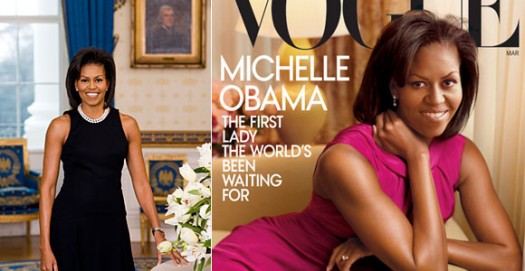
The Right to Bare Arms

Over the past few decades, I’ve watched the increase in women going sleeveless, strapless, and backless in all sorts of situations, including conference rooms and boardrooms—places in which men would never consider baring their upper arms (or pectorals, for that matter). Without going too far into the ramifications thereof in different eras (e.g., the slender unmuscled arms of Elizabeth Montgomery’s Samantha Stephens in Bewitched versus FLOTUS Michelle Obama’s toned “guns”), I would like to consider “the right to bare arms,” particularly in light of a recent piece about women and appearance.
In the September 2012 issue of Harper’s Bazaar, author and attorney Elizabeth Wurtzel published an essay titled “Looking Better at 45 Than 25,” in which she exhorts women to keep up appearances: “My mother taught me that even if all you are dealing with is a box of Tide and a bunch of junkies, without a coat of Revlon’s Cherries in the Snow, a real woman does not step out the door.”
There is much to debate in that sentence, and it’s not even the most deconstructable in the piece. However, what interests me far more than Wurtzel’s silly conflation of feminism and five-inch heels is Jezebel writer Katie J. M. Baker’s reminder of something Caitlin Moran wrote in How to Be a Woman: “I have one rule of thumb that allows me to judge … whether some sexist bullshit is afoot … are the men doing it? Are the men worrying about this as well? Is this taking up the men’s time? Are the men told not to do this, as it’s ‘letting our side down?’”
Well, the men are not baring their arms in places like boardrooms and banquet halls—and they never have—so they don’t have to worry about letting their side down. The only time you’ll see POTUS’s own “guns” are in the occasional hunka-hunka-burning Barack-in-swim-trunks vacation photos. President Obama, like all (and, it must be said, male) presidents before him, keeps his ripped biceps under wraps during official events.
I think the reason almost all professional men stay covered is because they are used to regarding their upper arms as sexy. From earliest adolescence, while girls are worrying about their breast development (or lack thereof), boys are worrying about their bicep development (or lack thereof). The concept of “arms and the man” may have its roots in weaponry, but that weaponry begins with … arms and what they can do. Yes, arms can be used to hurt, but they can also be used to love. Upper arms cover human axillaries—known as “pits” because their sweat glands breed stench. However, they also breed pheromones and are a powerful attraction for lovers. Upper arms embrace and hold and enfold; they’re close to our mammary glands and our hearts.
No, the men are not worrying about bare arms. They’re not sporting them, and so they don’t have to talk about or obsess over them. Men may want to have more muscular arms for a lot of reasons—for strength, for sexiness, for looking great in T-shirts—but it’s not simply so that they can uncover them, and they do not ask their friends “Do my arms look fat in this dress?” or engage in last-minute arm-toning workouts in order to attend weddings. Perhaps it’s because men have long been more concerned with what their arms can do than with what they look like.
Thus, to cover Moran’s last two questions, the men are not taking up time with this, nor are they accusing each other of “letting our side down.” They do not have to worry about one of their own sending out a screed a la Wurtzel, informing them they just need a little lipstick and some high heels to make it all better. Does this mean that wearing sleeveless garments is always inappropriate? No, it doesn’t. Does this mean that women should dress like men? No, it doesn’t.
What it does mean is that what is considered appropriate business attire for men and women has diverged. The reasons for this are complicated and complex and beyond the scope of this essay, but one thing can be stated with some certainty: Women are not going to return to dressing like men the way they did for a brief time in the 1970s and early 1980s, when trouser suits and blouses with floppy “ties” prevailed. They have chosen a different look.
If choice has prevailed—and, paging Dr. Freud, that is what women want—then one thing women truly can “learn from the boys” is not to let anyone else take our choices away. Yes, that means men, but it also means women, like Elizabeth Wurtzel, who would carelessly try to dictate those choices.
———
Bethanne Patrick (@TheBookMaven) is a writer and editor focusing on books and culture. Her work has appeared in AARP, O: The Oprah Magazine, and The Washington Post. She lives in Arlington, Virginia.

